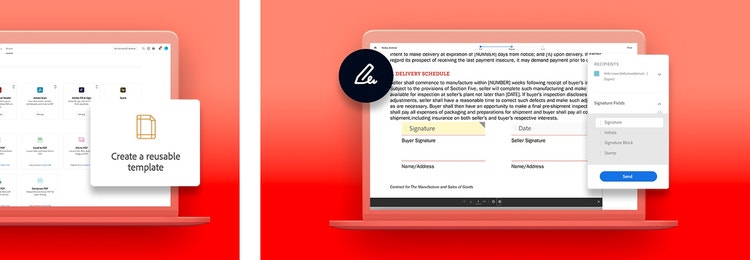Adobe Acrobat Sign
Define relationships with an MSA.
Learn where and why to use MSAs. Then discover how to create your own digital agreements to manage future business relationships.

What is an MSA?
MSA stands for the legal term master service agreement, which refers to a type of agreement that governs all future transactions or deals between two parties. These contracts can sometimes be called service level agreements (SLA), and they make it simpler for two people or businesses to have an ongoing relationship without having to draft multiple contracts for services from scratch.
With an MSA, it’s faster and easier to do business. It contains the legal terms and sets the standard for how you will structure your deals with the other party. Once you establish an MSA to define the larger terms of the relationship, you’ll fill out simple work orders or statement of work (SOW) agreements to set the terms of each individual project.
The importance of MSAs.
An MSA sets the foundation for how the relationship will work between a buyer and a service provider. It establishes a system for accomplishing projects and provides a framework for the terms of future work. You can also reference the MSA to resolve any conflicts that may come up during the duration of the business relationship.
Types of ongoing service agreements.
MSAs can be used in any industry where there are long-term relationships between clients and service providers. For example, an IT service provider can have a client sign an MSA to establish how they will pay the IT company for their time and services throughout the relationship.
A company can set a rate and payment schedule for their work in the MSA, and then list the actual price and time frame of individual projects and the expected deliverables in subsequent statements of work.
Many different types of companies may provide their clients with MSAs, including:
- Marketing agencies
- Tech and IT companies
- Independent contractors and subcontractors
- Companies hiring union workers

What to include in an MSA.
There is no one-size-fits-all MSA, because they vary tremendously depending on the type of customer, the nature of the services, the industry involved, and many other factors. Always get legal advice from a law firm with the know-how required to write an MSA so that the legal terms you lay out in your agreement are correct. The attorney’s fees will be worth it for the peace of mind you get.
Here are some basic sections you may want to include in your MSA:
Scope of work.
Set some general expectations for the type of work that will be performed.
Payment terms.
Define how pricing will be calculated and the payment deadline for invoices..
Allocation of risk.
Also referred to as an indemnification clause, this section grants people “indemnity” or protection against being held responsible for certain types of damages. It’s also a good idea to include a disclaimer about any damages that parties will be responsible for.
Intellectual property rights.
State who owns the intellectual property involved in the work and how both parties should use it.
Nondisclosure agreement.
Denote any trade secrets or confidential information that you would like your client to keep private and for how long.
Dispute resolution.
Set a framework for how you will resolve disputes if problems arise during your relationship. You can determine who is responsible for legal fees and whether you would like to resolve disputes through a mediator or through arbitration.
Termination clause.
Describe the severability of the agreement, meaning how each party can go about ending the relationship if need be. This should typically be done through written notice. Any fees associated with an early termination or breach of contract should be listed here.
Representations and warranties.
Provide a guarantee (warranty) of how the products or services (referred to legally as representations) will function for the client in the future.
Insurance coverage.
List any amounts of insurance coverage that either party requires.
Terms.
Define the length of the agreement and any renewal procedures.

Create an MSA template with Adobe Acrobat.
With Adobe Acrobat powered by Adobe Acrobat Sign, it’s easy to create fillable and signable PDF documents that you can share with your clients online. Once you create one MSA, you can use it to make a template to use again for each new client.
- Click the Home tab. Then click Create a Reusable Template and enter a name for your template.
- Upload your file and select Create as Reusable Document, Create as a Reusable Form Field Layer, or both.
- Choose your desired permissions option for sharing the template.
- Click the Preview or Add Fields button.
- Drag and drop your form fields.
- Click the Save button.
Go digital with your agreements.
Acrobat makes it easy to digitally manage contract paperwork, so client relations flow smoothly. Communications company PGi worked with Adobe to complete contracts in about 33 hours instead of several weeks, saving themselves time and money by going digital.
With digital agreements, you can work efficiently with clients from all over the world. And with a well-crafted MSA, you’ll know that your future agreements with your clients will be carefully mapped out.
